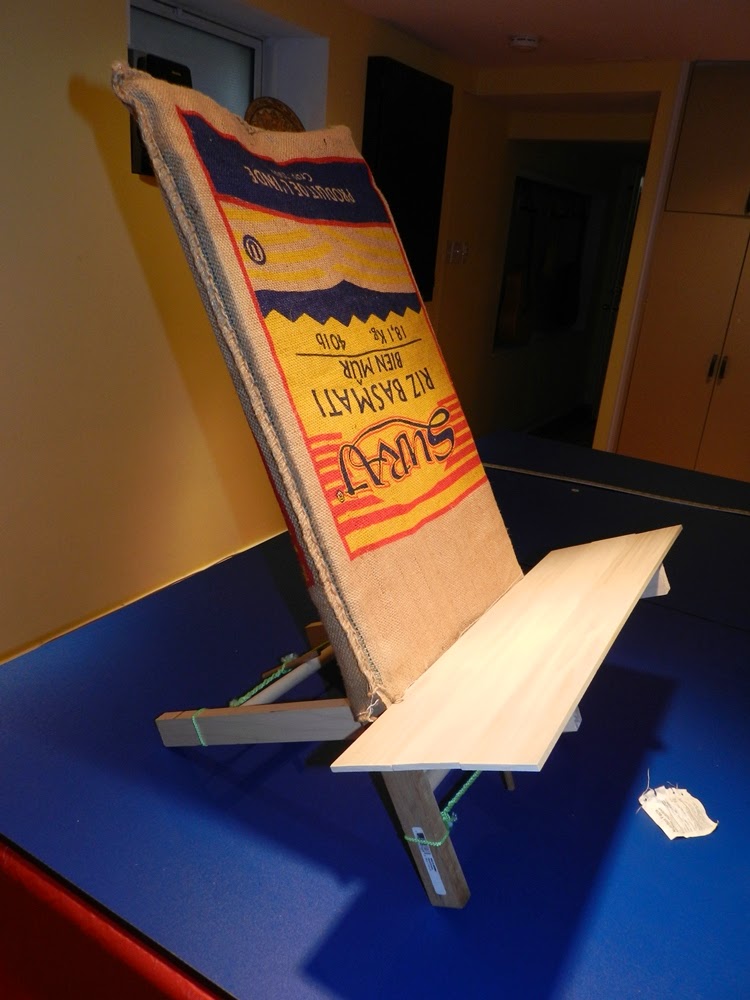After stumbling on Tony Miller's Pinterest page "Canoe Projects", I came across the source of inspiration...the Knudsen Bucksaw Chair!
Designed by Danish engineer Ole Gierløv Knudsen in 1962, it and an accompanying cot were created for a camping trip with his son. The original chairs from the 60s are apparently expensive collector's items today and are being re-made for the modern market, though mostly as indoor furniture for the urban chic crowd.
The chair is held together by the tension of the windlass cord and fabric. The wood components are custom carved and the whole thing collapses into a stuff sac.
For a while I toyed with the idea of recreating the exact chair, using scrap canvas to sew the fabric and some Sassafras for the wood components. But with less free time available lately, I simplified the idea with prefabricated scraps at home. All of the wood components were leftovers originally purchased at Home Depot, so they are pretty accessible. Here is what I came up with. Unofficially, it's called the Basmati Rice Burlap Bucksaw Chair.
Little different that the original inspiration in that there are two windlass cords for the front and rear legs with a fabric back and wooden slats for a seat. But the concept of using tension similar to a bucksaw is the same.
Here are the components laid out from top to bottom:
- Backrest fabric is a 17" w x 26" l burlap bag of rice - an old pillow case could work too.
- seat slats are 3 loose pieces of 1/4" x 2.5" w x 24" l poplar panels
- 2 seat legs made from a remnant of 1x2x8 of maple (actual dimensions are 3/4" x 1.5"w x 22" l)
- 2 backrest legs made from the same maple stock ( 3/4" x 1.5"w x 30" l)
- 2, 3/4" poplar dowels for the cross braces (long one = 13.5"; short one is 11-7/8ths")
- some cordage and 1/4 dowel sticks
Unlike the original Knudsen Bucksaw chair which has the seat legs nestled into a carved space on the exterior of the backrest frame, I ended simply attaching 2 cut block of maple onto each long using some glue and screws. Took some trial and error, but eventually settled on on placing these blocks so that the space created between would be 7" from the leg bottom.
Also, I ended deviating from the Knudsen design by purposely flipping the legs so that these notches facing inward rather than outward. The following sequence of pics might explain this better.
Here is the 1st step. Stick the long legs into the burlap sack with the "blocks" facing inward and tension with the cross piece and cord.
Then I place the other short legs into the support blocks and tension with the second dowel and cord. The tension created by the inner structure has a sort of friction lock at this stage. This is the view of the back of the chair...
Flip up and adjust how far back you want the chair to lean. This is accomplished by slightly squeezing the shorter seat legs towards each other near the block supports. The legs can then slide through the blocks and when you let go, they snap outwards again for an instant friction lock.
I had originally thought of using fabric for the seat again, but found that because of the width of the burlap back rest, something would need to be customized. I later got the inspiration from my 6 year old son who was playing with the 1/4" poplar boards building a sort of racetrack. I snagged 3 of his boards and found that they could easily rest, edge on edge on the projecting maple seat legs and sure enough work as a comfortable enough seat.
The take down process is quite fast and with the components stacked neatly and secured with the cordage it forms a nice bundle.
Here it is wrapped in the burlap sack. At 32" long, it just makes the cut for fitting in my Woods canvas pack. I also have an unused, narrow tent stuff sack that would be big enough to carry the whole thing and protect it from the elements if it needed to be lashed to the exterior. Or it could be lashed under the tumpline on the wanigan. Final weight is 4.8lbs. Like I mentioned before, it'll never be as compact and lightweight as the 2 lb Helinox chair, but I can live with weight difference.
















7 comments:
In the same multi-use, save-weight spirit of your stool/tripod, I'd love to see you modify this design to actually serve as a bucksaw. Easy for me to say, who couldn't design a doughnut even if someone gave me a hole for a start.
Thanks, Bob. The idea of somehow rigging this contraption up to serve as a real bucksaw would be a new challenge. I'd better start eating another 40lb bag of rice!
Ole Gierløv Knudsen is Danish, not Dutch.
Nice chair. :)
Thanks for the correction!
Hi I’m not sure if you’ll even see this comment but I’m a student and this term for product design we are constructing portable seats. I am in love with the design of yours and was wondering how you connected the dowels to each leg so that they could be taken off again. Thanks
Hello Kyiga. The dowels are not attached to the legs at all, but are simply cross braces held in place by tension. To keep them in position, I simply drilled socket holes about 1/2" deep. Holes should be visible in the 3rd photo from the bottom. Good luck with your design project.
thanks for sharing
Post a Comment